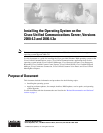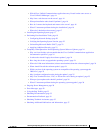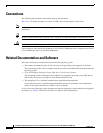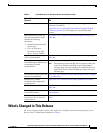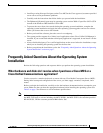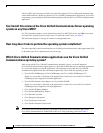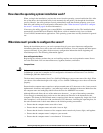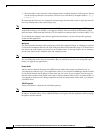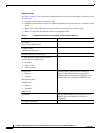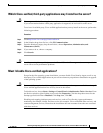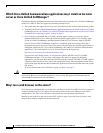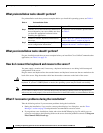
9
Installing the Operating System on the Cisco Unified Communications Server, Versions 2000.4.3 and 2000.4.3a
OL-10221-02
Frequently Asked Questions About the Operating System Installation
How does the operating system installation work?
When you begin the installation, you boot the server from the operating system installation disk. After
the system boots, the installation utility loads automatically and guides you through the installation
process; likewise, the utility performs several preinstallation tasks that include preparing your server
hard drive and loading server configuration information. (See “What data must I provide to configure
the server?” section on page 9 for more information.)
If necessary, the utility upgrades your system BIOS to a recommended version. The installation then
automatically installs Microsoft Windows 2000 Server, which is intended solely for use with the
Cisco Unified Communications applications. This operating system does not fully function for general
use.
What data must I provide to configure the server?
During the installation process, you receive prompts that tell you to enter important configuration
information about the server, such as the server name and IP address. You can complete the initial power
up more efficiently if you gather all the necessary configuration information before beginning the
installation process. The following information applies:
User and Organization Name
Registering the software product that you are installing requires user and organization name. Do not
leave the field blank. You can enter underscores, hyphens, numbers, and letters.
Computer Name
Caution Failure to adhere to the described naming convention will result in an inoperable Cisco Unified
CallManager system and a complete loss of configuration information and data on a Cisco Unified
CallManager publisher database server.
The host name (computer name) for a Cisco Unified CallManager server cannot start with a digit. When
you choose a host name that begins with a digit, a Cisco Unified CallManager server does not function
properly.
Ensure that the computer name comprises a unique network name of 15 characters or less. It may contain
alphanumeric characters and hyphens (-) and must begin with an alphabetical character. Make sure that
the computer name and workgroup labels follow the rules for ARPANET host names.
Although Microsoft allows the use of the underscore character (_) as part of the naming convention,
Cisco strongly recommends that you do not use the underscore character in the hostname for this
computer. The format for DNS domain names comprises labels that are separated by single dots. Each
label comprises 1 to 63 characters with a maximum of 255 characters, including the separating dots, for
the entire domain name. Labels must adhere to the following naming conventions:
• Ensure that the computer name starts with a letter.
• Ensure that the computer name ends with a letter or digit.
• Ensure that the interior characters of the computer name contain only letters, digits, and hyphens.
• Ensure that the computer name is unique to your network.
• Ensure that the computer name is a maximum of 15 characters.



